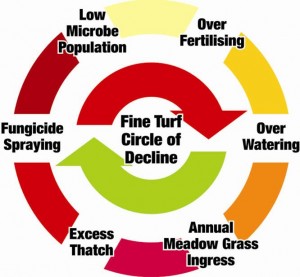With the end of the bowling season in clear sight, many clubs will have acquired a familiar temporary feature over by the roadside hedge somewhere. If you look closely there will probably be a pallet or five of bagged top-dressing, ready to go on the green as part of the autumn renovation program.
The bags might be plain or they might be covered in text and graphics proclaiming all of the benefits for your turf that are held within.
They are essentially Trojan Horses, in that they appear to be bearing good news and gifts, but they are actually full of sand (up to 90%) and represent the continued insistence of many clubs and consultants to pursue a program of desertification of bowling greens in the UK.
When your green was first constructed, it probably had an 8-10” (200-250mm) deep layer of topsoil (rootzone). An average bulk density for topsoil would be around 1.6 tonnes/m3. If we say that the average green is 36m X 36m we get an area of 1296m2. The volume of soil required to fill this is calculated thus:
1296 X 0.25 = 324m3
Using our bulk density average of 1.6 we can calculate weight of soil required as follows:
324 X 1.6 = 518 Tonnes. So our average green was built using approximately 518 tonnes of topsoil.
Most hollow tining operations can penetrate the soil to 4 inches (100mm) and this is usually used in conjunction with top-dressing. This then means that top-dressing operations have been concentrated on about 40% of the actual soil used to build the green (the top 4 inches). 40% of 518 tonnes is 207 tonnes.
30 years of top-dressing with 5 tonnes of material each time is equal to applying 150 tonnes of highly sandy material and this disregards the soil being removed by the hollow tiner! This also assumes that your club only jumped on the train to la la land in the 1980’s; many have been at it for at least a decade before that. I also know of some greens where they are routinely throwing 10 tonnes of straight sand on every year, so these figures are only averages and are probably leaning towards the less crazy end of the spectrum.
Is it any wonder then that greens suffer from localised dry patch, excessive thatch build up, powder dry inert soil, compaction, disease, low microbe populations etc, when almost all of the top 4 inches of the green has been replaced by sand?
If this is the plan for your club this autumn it would be better for your green, if you just do nothing. Yes, even neglecting the green and failing to undertake any autumn renovation would be much less harmful to the long term health and performance of the green than following this program.

